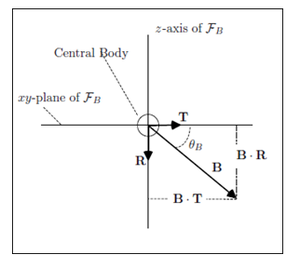Difference between revisions of "Earth-Mars Transfer Trajectory"
m (adding thumbnail) |
(work in progress) |
||
| Line 1: | Line 1: | ||
An Earth-Mars transfer trajectory is an orbital path which a spacecraft follows to travel between Earth and Mars. Several types of trajectories have been studied, but all must satisfy the following conditions: | An Earth-Mars transfer trajectory is an orbital path which a spacecraft follows to travel between Earth and Mars. Several types of trajectories have been studied, but all must satisfy the following conditions: | ||
| − | [[Image: InSight Trajectory.jpg|thumb| | + | [[Image: InSight Trajectory.jpg|thumb|right|px|Earth-Mars transfer trajectory of NASA's InSight lander, including planned trajectory correction maneuvers (TCMs)]] |
* The starting point must intersect the Earth in its orbit around the sun | * The starting point must intersect the Earth in its orbit around the sun | ||
| Line 8: | Line 8: | ||
There are many variations on this theme, such as whether the spacecraft ends in a Mars-centered orbit or if the spacecraft directly enters the atmosphere from the heliocentric transfer orbit. Other less common variations include the starting orbit at Earth, which could be a low Earth orbit or could instead the mission could begin from geostationary transfer orbit (GTO) as in the MEGA proposals of the late 90's, or one could vary the heliocentric portion of the flight to include a low-thrust trajectory. | There are many variations on this theme, such as whether the spacecraft ends in a Mars-centered orbit or if the spacecraft directly enters the atmosphere from the heliocentric transfer orbit. Other less common variations include the starting orbit at Earth, which could be a low Earth orbit or could instead the mission could begin from geostationary transfer orbit (GTO) as in the MEGA proposals of the late 90's, or one could vary the heliocentric portion of the flight to include a low-thrust trajectory. | ||
| + | |||
| + | ==Targeting== | ||
| + | |||
| + | I'm not sure what is used for targeting the initial transfer orbit insertion burn, but the trajectory correction maneuver burns target a point on the "B-plane" of Mars. The B-plane is defined by the NASA glossary as the "plane perpendicular to the asymptote of the incoming hyperbolic trajectory of the object relative to the Earth."<ref>https://cneos.jpl.nasa.gov/glossary/b_plane.html</ref> I think of it as the "bullseye" plane, which is the plane of the dartboard from the perspective of the person throwing darts. B-plane targeting was originally developed for gravity-assist maneuvers, but it has come to be used for missions where the destination is the planet itself as well. | ||
| + | |||
| + | [[Image: B Plane Targeting.png|thumb|left|px|B Plane used for targeting trajectory correction maneuvers]] | ||
| + | |||
| + | |||
| + | ==topics to elaborate on== | ||
| + | * opposition vs conjunction class transfers | ||
| + | * really nail down b-plane stuff with diagrams | ||
| + | * porkchop plots | ||
| + | * launch windows | ||
| + | * plane changes | ||
| + | * low-thrust trajectories | ||
| + | * earth orbit part, launch sites, equatorial vs polar parking orbits (or lack of difference between them) | ||
| + | * GTO to Mars transfer scheme | ||
| + | * mars capture schemes: aerobraking, ballistic capture | ||
| + | |||
| + | ==References== | ||
Revision as of 06:27, 3 October 2018
An Earth-Mars transfer trajectory is an orbital path which a spacecraft follows to travel between Earth and Mars. Several types of trajectories have been studied, but all must satisfy the following conditions:
- The starting point must intersect the Earth in its orbit around the sun
- The ending point must intersect Mars in its orbit around the sun
- The intervening trajectory must be heliocentric, though one or more gravitational swing-bys of other bodies are allowed
There are many variations on this theme, such as whether the spacecraft ends in a Mars-centered orbit or if the spacecraft directly enters the atmosphere from the heliocentric transfer orbit. Other less common variations include the starting orbit at Earth, which could be a low Earth orbit or could instead the mission could begin from geostationary transfer orbit (GTO) as in the MEGA proposals of the late 90's, or one could vary the heliocentric portion of the flight to include a low-thrust trajectory.
Targeting
I'm not sure what is used for targeting the initial transfer orbit insertion burn, but the trajectory correction maneuver burns target a point on the "B-plane" of Mars. The B-plane is defined by the NASA glossary as the "plane perpendicular to the asymptote of the incoming hyperbolic trajectory of the object relative to the Earth."[1] I think of it as the "bullseye" plane, which is the plane of the dartboard from the perspective of the person throwing darts. B-plane targeting was originally developed for gravity-assist maneuvers, but it has come to be used for missions where the destination is the planet itself as well.
topics to elaborate on
- opposition vs conjunction class transfers
- really nail down b-plane stuff with diagrams
- porkchop plots
- launch windows
- plane changes
- low-thrust trajectories
- earth orbit part, launch sites, equatorial vs polar parking orbits (or lack of difference between them)
- GTO to Mars transfer scheme
- mars capture schemes: aerobraking, ballistic capture








